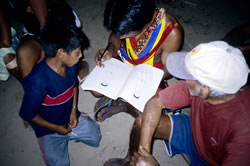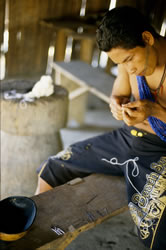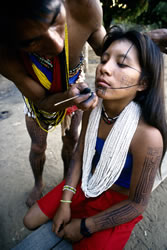Kayabi Names
The Kayabi change their names many times during their lives. This practice coincides not only with particularly significant periods in life (e.g., birth, puberty, parenthood, or after killing an enemy) when they take on new identities and responsibilities, but also with the accumulation of “knowledge” over time which makes them “more complete” individuals.
Once a Kayabi individual reaches adulthood, that person is acknowledged as having passed through several significant rites of passage and is believed to have the capacity to finally “understand” (-kwaap) the world more fully. In turn, it is believed that the specific individual has learned to interact with “others” of various sorts – other ethnicities when traveling abroad, other spirits (sometimes ancestral), and even other families into which one marries. Through these interactions with “others,” personal knowledge of them grows to the point where the person begins to assume some of their attributes, such as their ways of speaking, emotional states, or even their behaviors. In such cases, they are usually given the name of an ancestor, an animal, or spirit being they resemble in thought, action, or appearance.
Kayabi shamans, however, always have more names than laypersons because of their special relationship with their spiritual guides called ma’it. Ma’it live underwater, up in the sky, deep in the forest, or at the horizon, and provide shamans with “complete knowledge” (ikwaapat) of the whole cosmos, and the spiritual beings and gods that inhabit it. After many dream meetings with the shaman, these spirits often exchange their names with him to increase his physical, spiritual, or even curative powers. These names were usually tattooed as name glyphs on the forearms of the shaman, and the power embodied in them was oftentimes called upon when a shaman traveled to the spirit world to retrieve the lost souls of his sick patients from evil spirits. Although the powerful Kayabi shaman Tuiarajup does not have any tattoos (his deceased father was heavily tattooed), he proudly displayed to me the numerous scars on his body from “battles” with spirit beings during his ecstatic travels. |
 |
Jemy’s tattoo book contains over one-hundred tattoo designs, and approximately fifty for the face alone. His book has been bound and distributed to all of the Kayabi in his village so that they can share, learn, and keep it in their memories. Photograph © Lars Krutak 2007-2010 |
Of course, Kayabi shamans traditionally provided new parents with the names for their newborns, or even the new names associated with boys and girls who have completed their initiations; because only shamans had the power to contact deceased ancestors or other supernatural beings like ma’it that are the repository for such names.
Tuiarajuptold me “in my spiritual dreams, each spirit provides me with a different name symbol or glyph which will become the tattoo we place on the body. Each symbol has a spirit attached to it, and sometimes the spirit of the name even appears before me. You know, these spirits also have tattoos on their bodies, and even if you die and are not able to be tattooed, the spirit will give you all of the tattoos you deserve depending on how you live your life.”
|
|
The names corresponding to the tattoo were sometimes descriptive: they were related to the shape of the design, to the placement on the body, and to the size of the mark. For example, several elder Kayabi men have tattoos on parts of their bodies that correspond to their adult names. One elder whose name was “Monkey Leg” had tattoos placed on his leg. One chief named “Chest” had two bars tattooed on his chest, and another elder named “Arm” also had two bars tattooed on his upper arm. Of course, I was told that one very old Kayabi man in another village had two barely visible bars tattooed across his chest, and these were given to him after he killed an Ikpeng enemy long ago and took his name. |
Still more tattoos could provide their wearers with specific powers attributed to the spirits that were embodied in them. For example, a frog placed on the shoulder or arm was related to a group of spirit masters in the lineage of the frog that are protective in nature. Moreover, great Kayabi warriors wore jaguar tattoos on their foreheads or had two jaguars tattooed upside down beneath their eyes called towaja’wat so that they could hang from trees or jump on their “human” prey without injury. To be tattooed in such a way not only gave you great status amongst your peers, but it was also believed that your behavior would change after receiving the tattoo because you became more “jaguar-like.”
Conversely, other types of tattoos were given to young men “to teach them a lesson.” My good friend and aspiring tattooist Kurapireceived his facial tattoo from a relative who was the last great Kayabi tattoo master. The Kayabi word kurap means “to insult,” and Kurapi told me that “as a little boy, I always complained to my parents about work, about food, about everything. I was a prankster and a pain in the ass to my family. My cousin, the tattoo master Yxyt who was murdered by Brazilians four years ago, consulted with my parents and the local shaman to have my name changed to Kurapi after my initiation, and to have my face tattooed. Yxyt and my father wanted me to feel pain so that I would stop complaining: so that I would understand how to become a man, and stop taking all the things in my life for granted. Sure enough, and after my tattoo, I never complained again because I became more knowledgeable about becoming an adult and how to become a father and a husband. I have to tell you that I learned many things from my elders during my seclusion, and now all of my male relatives are my role models. Now that I am tattooed, I have gained the respect of the community.”
The Art of Kayabi Tattoo
As noted, there were many types of tattoos associated with personal names which were either: selected by the shaman and passed down through the family line; or they were taken from a deceased enemy. However, both Kayabi men and women have always worn different styles of facial tattooing which served as a tribal insignia; one that made them recognizable to their enemies. Of course, if a young boy, girl, or an adult woman was captured during a raid on an enemy village, these individuals were typically tattooed in the Kayabi style and integrated into the community. However, as the tattoo historian and tattooist Jemy Kaiabi told me, “girls who were abducted, raised and tattooed as Kayabi, and then married to Kayabi men almost always caused problems for their husbands. Eventually, they had to be killed only after a few years of living in the village.”
Aspiring tattoo artists, who were traditionally male, usually apprenticed under a tattoo master for months and even years learning the requisite skills and raw materials needed to prepare the tattooing needles and pigments derived from various trees growing in the jungle. Tattoos (-jupot)were applied with the long thorns of the tucum palm. Two such thorns were wound together with a piece of homespun native cotton thread. The depth of the thorn pricking was controlled with another piece of cotton thread wound near the bottom of the thorn. The small reservoir that was created between the tips of the two needles held the tattoo pigment, which was a resinous material obtained from the bark of the ipau-ip tree mixed with charcoal and water. Because the ipau-ip tree is rare in some regions and difficult to identify, the sap from the rubber tree was often used as a substitute: although it only worked if mixed with the correct amount of water. When completed, the tattoo pigment acquires a sticky consistency.
The pigment is placed in a coconut bowl and the area to be tattooed is cleaned with a small bundle of cotton and water. Next, the tucum thorn tool is dipped into the resinous mass and pricked into the skin using the thumb and index finger. Each tattooed line receives at least two or three layers of pigment, and then the thorn is used as a kind of paintbrush to push-in more ink. Kurapi told me that the long lines that were tattooed across his cheeks took four hours each; each line receiving two layers of ink and thousands of bloody pricks!
 |
 |
Kurapi is not only Jemy’s tattooed cousin; he’s another aspiring Kayabi tattoo master. He said, “I want to bring back the tattooing tradition we’re losing and to help my people. The youth are losing their culture and especially their tattoos. I have to become a tattoo master because it is the only way to bring tradition back to our people.” Here he prepares some tattooing tools with cotton thread. Photograph © Lars Krutak 2007-2010 |
Jemy is always practicing his tattooing skills on willing community members. Here he is stenciling facial designs on a family member. Photograph © Lars Krutak 2007-2010 |
Some of the Kayabi I spoke with also used the term jemoun to refer to their tattoos. However, this term specifically refers to the semi-permanent body paint they use during everyday and ceremonial occasions. In fact, many indigenous groups living in the South America continue to use this blue-black substance as body paint, and in the past as tattooing pigment. More specifically, jemoun means “to paint black with genipapo,” and juices of the green, immature fruits of the genipapo tree were used at least 1,000 years ago by the Pre-Columbian Chimú people of Peru as tattoo pigment. Caches of their mummies have been found with each individual clutching the fruit in the palm of their hand – a tradition that is practiced today by some indigenous groups in Guatemala who believe that holding the fruit in their hand will provide them with protection from disease and misfortune. The Apiaká and Mundurucú, who were traditional enemies of the Kayabi, also utilized genipapo as body paint, but also as tattooing pigment. The Mundurucú also painted their trophy heads captured in war with genipapo because it was believed to protect the victor from the sometimes malevolent spirit of the deceased.
Next Page | 1
|
2 |
3 |
4 |
5 |
6 |
7 |
8 |
Museum photo gallery of the images
on this page may be seen here. |



